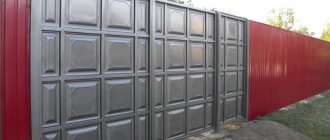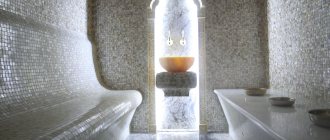A pond is a wonderful decoration for a summer house. It can be arranged even in a small area without the help of professionals. If desired, you can put fish in it or grow plants.
The first thing you need to think about when choosing a base for a pond is what its volume and shape will be. The pond can have the most natural shape possible, decorated with stones and aquatic plants.
Photo: Instagram nastya_shi_za
Or have a clear geometric shape. It all depends on the design style of the site.
Photo: Instagram _idei_dizainakrasoti
- Baths, saunas, swimming pools
How to make a shower in the country with your own hands: tips on installation and selection of materials
What could a pond be like?
First, it is necessary to determine the primary purpose of such a structure, and only then begin the construction of the structure and its further design.
So, according to functionality, an artificial reservoir can be divided into the following types:
Small ponds. They relate more to the landscape composition, complementing the overall picture. It won’t be difficult to create such a reservoir, but it won’t be possible to have active recreation nearby.
Decorative ponds. They have a slightly greater depth, and, as a rule, are subject to decoration with additional elements. These can be bridges, fountains, and much more.
For breeding fish. This pond will appeal to avid fishermen and will definitely please children, who will be able to watch colorful fish.
Swimming pools. An artificially created body of water that performs many functions, especially if its dimensions allow for swimming.
If you have already decided which option to choose, then it’s time to move on to the next stage.
Cleaning
An artificial swimming pond, like other bodies of water, tends to become dirty over time. This could be some kind of mechanical waste or particles of clay, algae, or fallen leaves that were not removed in a timely manner. To combat the negative impact of debris, use a sand-gravel bed or non-woven synthetic filter materials. Naturally, the filtration system and water pumps make their contribution to the cleaning of the swimming pond.
To keep the bath clean, it is important to maintain the correct oxygen content in the water, for which aeration is used. Sometimes a fountain can be built for such a purpose, the issue is finances. However, this method also solves a decorative issue.
Deciding on the installation location
The pond needs to be installed in a place where you can admire it, and not hide it behind seven seals.
Accordingly, when creating such a masterpiece, it is worth considering several points: area, light, relief, presence of groundwater, soil composition, reflection, landscaping, visibility, power supply (if necessary), the ability to further expand your creation.
The list of work on the construction of an artificial pond should begin in the spring. This is necessary so that the latter can “take root.”
Mistakes when constructing a reservoir
When building your own swimming pond, the following mistakes are sometimes made:
- The location for the pond was chosen incorrectly (in this situation, the easiest way is to fill in the pond and make it in another place).
- Inappropriate time (if you build a bathhouse at random in any season, then there is a high risk that in other seasons the level of groundwater will change, which will cause harm in the future, which means that it is correct to first track how groundwater behaves at different times or redo all work upon their discovery).
- Oversized (difficulties are solved by selecting unpretentious plants, installing powerful and strong pumps and filters).
- Saving on materials (the decision comes down to the principle “the miser pays twice”, that is, you will have to carry out restoration work and purchase a quality product for repairs)
- Failure to comply with safety (if the banks are too steep, they can be cut off, for example, with a shovel; install fences for children, strengthen decorative stones)
- Lack of water drainage (you will have to dig an additional trench or install a special pump)
- Ugly or overloaded decor (you should seek help from specialists)
- Selecting the wrong plants for the pond (remove all fast-growing plants that take up too much space, replace with unpretentious types of oxygen-generating plants).
- Inappropriate equipment (if the equipment that is installed does not cope with its tasks, then it should be replaced with a more powerful one).
Selecting materials
No repair can be done without building materials and tools that meet the requirements.
Construction companies offer a wide range of similar consumables in stores and markets, but you shouldn’t chase the cheap.
Give preference only to trusted intermediaries, and if necessary, check quality certificates.
In order to make a pond, you may need materials such as:
Concrete. An expensive but high-quality solution that extends the life of the pond for several decades to come.
Plastic. In specialized stores you can purchase a ready-made bowl, which will become the future pond if properly organized.
This option can also last for a long time, which largely depends on the quality of the element’s manufacturing.
Polyethylene film, PVC. This is the most affordable option in terms of finance, but the worst in terms of service life.
Construction
Now that we have calculated the required amount of film for the future reservoir, we need to prepare a hole, the so-called “bed”, where this film will be laid. And here's how it's done.
The construction of a bed for a pond begins with planning and choosing a place in the garden
The larger the garden, the more opportunities there are to create a pond. A film pond with a water surface area of 6 square meters. m should be considered as an absolute minimum; it is better to have a reservoir with an area of 8 to 10 square meters. m. Let me emphasize once again that this applies only to ponds made of film, and does not apply to small forms or large pools or bathtubs made of plastic.
Once a location has been selected and its size and shape determined, mark the contours of the pond on the ground using a flexible hose or thick rope and pegs. Make the necessary adjustments until you are completely satisfied with the shape and size of the future pond.
A film pond should be as large as possible not only from an aesthetic point of view, this is important for maintaining biological balance in it, which occurs on average 2 years after its construction. The minimum depth of the deepest zone of the pond should be 80 cm.
Now you can remove soil from the pit
Dig a stepped hole and check the horizontal surface of the terraces with a level, add or remove excess soil in the right places. Terraces will be required to place containers with plants on them, or to make it convenient to enter the water when swimming. Remove all large roots, stones, and construction debris from the pit, level the bottom and edges well and begin laying sand.
After compacting the sand, before spreading the film, it is recommended to line the bottom with non-woven synthetic material (geotextile). You can use old blankets and other available materials. This cover will protect the film from damage. Then the bed of the future reservoir is covered with film.
One useful tip: lay it out in a sunny place in advance - it will become much softer and more elastic.
Try not to damage it when installing. You will need a helper as it is not that easy. The edges of the film should protrude 30-50 cm beyond the perimeter of the reservoir. Now you can gradually fill the bed with water, the pressure of which will begin to press the film into the sandy base, and the edges of the film will begin to tighten.
Butyl rubber as insulation
Undoubtedly, this is one of the most optimal options for organizing and strengthening a pond.
If the chosen option involves a rocky bottom and greater depth, then experts recommend using a membrane made of this material.
The service life of the structure in this case can reach over fifty years. In addition, an indisputable advantage is the fact that the material can withstand sudden temperature changes.
Options from the people
If all the ideas listed above do not suit you, then you can use other solutions. For example, you can take an old bathtub and turn it into something that will be the envy of all the neighbors around.
Everything here is extremely simple, since the bathtub was originally designed to retain liquid, so in this regard, when organizing a pond with your own hands.
If you are still interested in how to make a pond, then it is worth learning more about other landscape ideas.
Alternative methods of waterproofing
In addition to the popular options of films, bowls and concreting, there are other ways to retain water in the tank. Let's name just a few.
Liquid rubber over a layer of geotextile . In this case, the pit is prepared as usual, but it is covered not with film, but with special geotextiles. Liquid rubber is applied on top of it in several layers. This option is especially good for small reservoirs with difficult terrain.
Tamper with a clay castle device . The method is quite complex, requiring the use of heavy equipment for compaction and therefore used mainly for large ponds for economic purposes. You can just build a clay castle with your own hands, but even in this case you will have to work hard.
Gabions and gabion structures . Metal mesh filled with stone - gabions - can be successfully used to fence the banks of a pond. Waterproofing will be required in any case, but the rapid formation of aesthetically attractive banks is guaranteed. Another convenience is that you don’t have to dig a pit, but make the reservoir above ground level.
Tires on the move
Tires are a very affordable material that our people have learned to use in different ways, and the home pond is no exception.
True, in this case it will be more of a pond, but still. The creation principle is simple, and looks like this:
- We cut the wheel on one side;
- We cultivate the ground to remove weeds and debris, compact the soil;
- Place the film tightly;
- We decorate;
- Fill with water;
- We enjoy our work.
Decorating a pond at the dacha is a painstaking task, but worth all the effort and money. You can aim for a massive project or be content with a mini-copy of a pond; here everything depends solely on the mood of the owners.
In any case, you can be sure that the result will be an incredibly beautiful decor, near which you can gather for a picnic on a summer day, or just relax looking at the pond.











